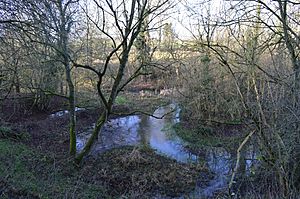Letcombe Valley facts for kids
Letcombe Valley is a special nature reserve covering about 7.5 hectares (that's like 10 football fields!). It's located south of a village called Letcombe Regis in Oxfordshire, England. This beautiful place is looked after by the Berkshire, Buckinghamshire and Oxfordshire Wildlife Trust (BBOWT). They work with a group called the Friends of Letcombe Valley to keep it safe for wildlife.
Contents
History of Letcombe Valley
This land was once part of a large estate known as Benhams. In 1851, a man who owned racehorses, Thomas Parr, bought the property. After the Second World War, the estate changed. It became a place for scientific research.
Later, in 1985, a company bought the research center. This company decided to create a nature reserve right next to the Letcombe Brook. When the research center closed in 2002, most of the land was used to build homes. However, the nature reserve part was saved! In 2010, BBOWT was given a 50-year agreement to manage the reserve. This was part of the deal for building the new houses.
Amazing Wildlife and Habitats
Letcombe Valley is home to many interesting creatures and plants. A very important part of the reserve is the Letcombe Brook.
The Special Chalk Stream
The Letcombe Brook is a rare type of river called a chalk stream. These streams are fed by water that flows through chalk rock. This makes the water very clear and clean. There are only two chalk streams in all of Oxfordshire. Across the whole country, there are only 161 of them!
Animals of the Valley
Many animals thrive in this clean water and natural environment. You might spot water voles, which are small, furry creatures that live near the water. Fish like the bullhead, brown trout, and the ancient-looking brook lamprey swim in the brook.
In the evenings, Daubenton's bats fly over the water. They use echolocation to catch insects. The valley is also home to many different insects, including some rare types of flies.
Different Natural Areas
Besides the chalk stream, Letcombe Valley has other important habitats. There's an area of very old woodland, which means the trees have been growing there for a long, long time. There's also a small section of chalk grassland. This type of grassland has special plants that grow well in chalky soil.
How to Visit Letcombe Valley
You can visit Letcombe Valley by using a public path. This path is a bridleway, which means it's suitable for walkers, cyclists, and horse riders. You can find access to the reserve from the top of South Street.


